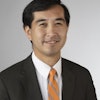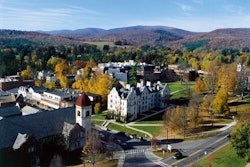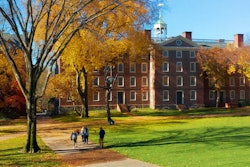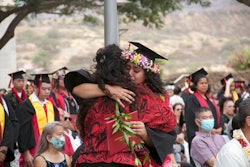Connecting The Classroom and the Community
Service-learning programs allow students to apply real-world experience with classroom study
By Phaedra Brotherton
The events of Sept. 11 have been credited with awakening a desire for many to do something meaningful and give back to their communities. But for the past decade, a growing number of institutions of higher education have been doing their part in developing civic-minded citizens through service-learning programs that allow students to earn credit for performing community service.
More institutions have bolstered their service-learning efforts by joining Campus Compact, a coalition of more than 800 public and private two- and four-year colleges and universities. The coalition promotes community service to develop students’ citizenship skills and values and to encourage partnerships between campuses and communities.
Campus Compact formed in 1985 at a time when the media portrayed college students as materialistic and self-absorbed and more interested in making money than in helping their neighbors. The presidents of Brown, Georgetown and Stanford universities believed this public image was false after witnessing the many students on their campuses involved in community service. The founders believed other students would participate in community service if they had campus support. Campus Compact formed to encourage and support more students in serving.
Liz Hollander, executive director of Campus Compact, says the organization’s membership continues to increase due to a growing concern in the country about educating citizens who will actively participate in the democracy.
As more colleges and universities see the need to be engaged in their surrounding communities, Campus Compact has seen the number of its member colleges grow from 235 in 1991 to 814 today. A 2001 study of its members shows 72 percent offer service-learning courses; another 87 percent have formal community service programs.
One reason for the growth, says Hollander, is that service learning is a powerful form of teaching. “The most powerful learning experience is when you teach somebody else,” she says. “The second is when you do something. Service learning does both.”
In general, service learning combines community service with classroom study, which includes discussions, readings and writings to reflect and integrate the students’ experiences. To ensure learning has taken place, students must reflect on their experiences, often in the form of journal entries, field notes and essays.
HBCUs: A Tradition of
Community Service
Service-learning programs are enabling historically Black colleges and universities to extend an already existing tradition of community service.
“Within African American colleges, the notion of leadership and service are interchangeable,” says Dr. Barbara Frankle, dean of academic affairs, at LeMoyne-Owen College in Memphis, Tenn. “Students have been trained to uplift everyone in the community, not just the individual students. That is a very strong ethos.”
However, much of the service done at HBCUs has been on an informal basis. Instituting service-learning programs often formalizes and documents much of what these institutions are doing. In 1993, the Ford Foundation awarded a grant to the United Negro College Fund to help formalize service learning at HBCUs and to steer them in the direction of the national movement, says David B. Ray, director of community outreach programs for the UNCF. The UNCF awarded grants in 1993 to 10 member colleges — including LeMoyne-Owen College and Johnson C. Smith University — that submitted proposals for the funding to further their efforts in service learning.
The service-learning program at LeMoyne-Owen includes an upper-level service-learning course and a “one-plus” program where students can earn an extra credit toward a course by adding an approved and relevant community-service component.
LeMoyne-Owen poetry students have done poetry readings for senior citizens. Students in science courses have done environmental justice projects. Courses have to be approved by the faculty member and service-learning coordinator.
“Our students like to focus on youth and the way they can benefit youth in our communities,” Frankle says. “For instance, our library is open to the surrounding neighborhood from 3 o’clock on. Often college students find themselves helping schoolchildren write their first term paper.”
Many of LeMoyne-Owens’ service-learning programs focus on tutoring and mentoring students from the surrounding public schools. Students also work with local community organizations and have formed partnerships with a local high school, junior high, elementary and alternative schools.
All LeMoyne-Owen students are required to take a freshman social science course that gets them into the community to participate in a Junior Achievement program with third- and fourth-graders. Juniors and seniors also can take a general service-learning course, which allows them to participate in a structured community service project related to their majors. Students must complete a short essay on their expectations at the beginning of the course and a detailed exit paper reflecting on the actual learning experience at the end.
At Johnson C. Smith University based in Charlotte, N.C., formal service learning started in 1994. Service learning is embedded in the infrastructure of the liberal arts program and is curriculum- and discipline-based, says Dr. Rosalyn Jones, dean of the College of Arts and Sciences.
One example is the freshman composition class. To assist minority students in the Charlotte area, all freshman composition students tutor and mentor elementary school students in reading and writing skills during a three-hour Saturday morning program on campus.
Students from JCSU also have been involved in adaptive physical education classes and worked with students with disabilities through the Special Olympics, and students studying gerontology have volunteered at a community center for senior citizens. In all cases, students working in community agencies go back to the classroom and reflect on their experiences through writing or presentations. JCSU students must complete 40 hours of community service to graduate and can earn the hours through service-learning courses or by carrying out approved short-term community service projects.
Learning Through Exposure
For many students on predominantly White campuses, service learning has been an avenue of exposure to at-risk and minority communities for the first time.
“My own experience has been that often times (on predominantly White campuses) it is the students who are more privileged going into diverse communities with a sense of doing good and offering something,” says Jean Wu, program and education director of the Office of Diversity Education and Development and senior lecturer in American studies at Tufts University in Medford, Mass. Wu has created a course, “Building Bridges in Chinatown: Active Citizenship in Urban Communities, Race, Culture, Power and Politics.”
The course, held for the first time this year, aims to educate students on the culture, history and perspectives of the communities that students will be going into so students can put their experiences into context, Wu says.
In previous volunteer efforts, Wu says, students dropped out because they could not relate to the communities in which they were working. Wu’s class aims to prepare students for working in various community service or “active citizenship” assignments in neighborhoods like Boston’s Chinatown, and Dorchester, a predominantly African American community in the Boston area. The feeling is that if the students are more educated about the communities in which they plan to work and volunteer, the more likely the students are to stay in the program.
In the Tufts program, students go to their particular community agency or organization every week and then spend about three hours in class once a week discussing their experiences. Wu says this is “to engage them in learning about the community inside out.”
The course brings in community leaders and representatives from different organizations and agencies to talk about difficult issues, such as gentrification, affordable housing, diverse immigrant populations, racism and environmental racism.
One student in the class, MaryAnn Triest, whose mother is a Japanese immigrant, has found her experience tutoring immigrant children in English as a Second Language (ESL) in Boston’s Chinatown enlightening. Before working in the community, Triest says she never thought of Chinatown as the home of an actual community of people, but rather a place to dine out and go shopping.
“I grew up in a mainly White suburban town. We had a big playground. These kids have none,” Triest says. “I’d never been in an urban school. The issues they face are different.
“Going there and interacting with them was the most valuable part of the experience,” Triest added.
Triest, who entered the class as an international relations major, has changed her major to child development and Asian studies and plans to pursue a career as a teacher, social worker or child life specialist.
Challenges to
Overcome
While there are benefits to service learning, a primary challenge is the increased time commitment on the part of students and faculty. Hollander of Campus Compact says some faculty are skeptical about whether service learning truly enhances learning and is worth the extra time commitment. “The challenge is helping faculty understand that this is about learning,” she says.
The logistics associated with community engagement, such as sending college students off campus or hosting community schoolchildren on campus also can be an issue. Many successful programs, including the ones at LeMoyne-Owen and Johnson C. Smith, employ a special service coordinator responsible for community outreach, handling the logistics and legal concerns associated with students working off campus, as well as training and coordinating the community service work of faculty and students.
Despite these challenges, however, proponents say students and institutions reap several benefits from service-learning programs. Adding a service-learning component to class work has enabled many HBCUs to obtain funding and to develop more programs, says Ray of the UNCF. Exposing students to different career opportunities is the practical element of service-learning programs, Ray says. There’s even evidence that it’s a great way to retain students.
“You have an energized classroom,” Ray says. “You are extending the classroom into the community and the community into the classroom.”
The feedback from students also has been very positive. Frankle of LeMoyne–Owen College says the experience makes students more confident and instills a commitment to give back.
“A lot of students refer to a sense of growth,” Frankle says. “They generally report when they start the program they’re nervous. They didn’t know they had the ability to give like they now know they can.”
Jones of Johnson C. Smith agrees and says students often are changed by their experiences. Students may go in with one idea but after working with diverse groups of people, “attitudes change and they gain a more mature outlook.”
For more information on Campus Compact, visit <www.compact.org>.
© Copyright 2005 by DiverseEducation.com





















